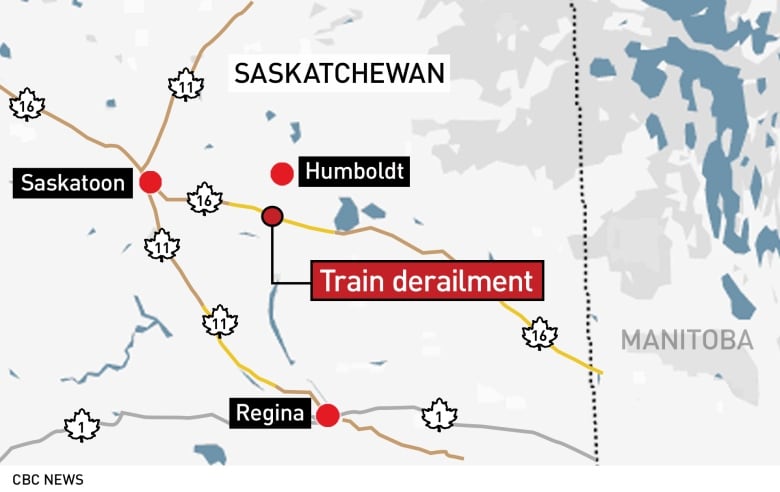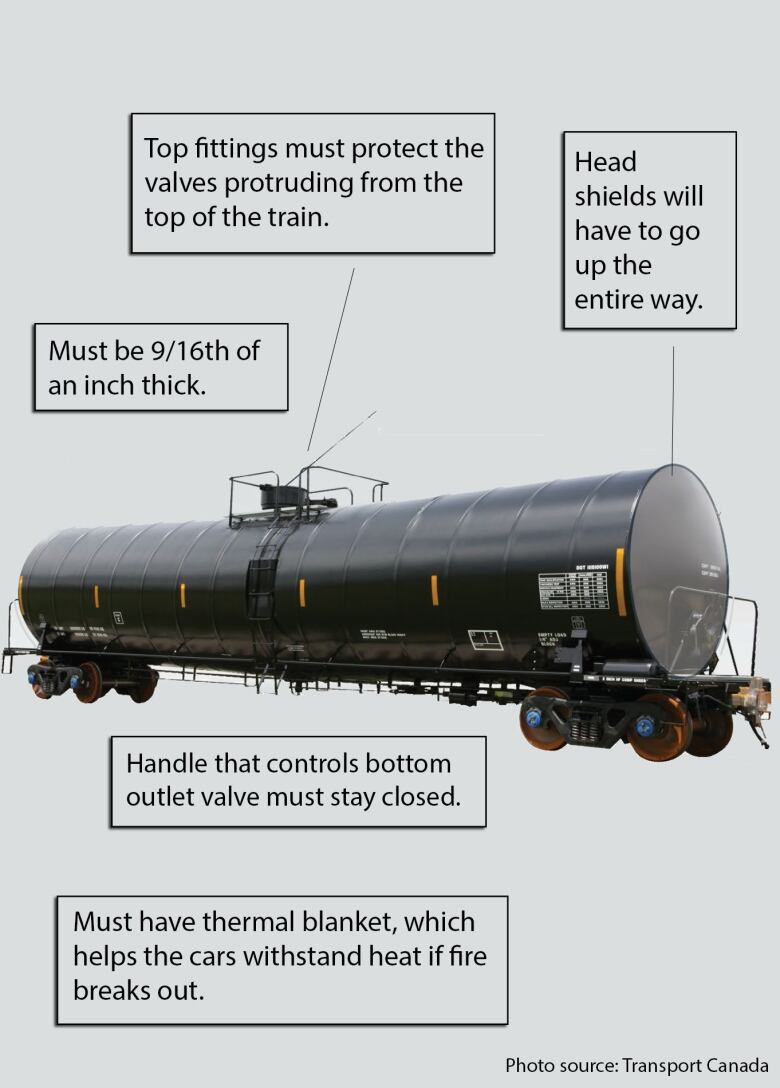Derailed Sask. CP train leaked more than 6 times the amount of oil than 2016 Husky pipeline spill
An estimated 1.5 million litres of crude oil leaked from the train, the TSB says

- Click here for the latest story:Rail tank cars involved in fiery Sask. derailment not thickest available, expert says
The Canadian Pacific Railway train that derailed in rural Saskatchewan earlier this week leaked more than sixtimes theamount of oilspilled during the 2016 Husky Energy pipeline disasterin the same province.
An estimated 1.5 million litres of crudeleaked from the train, the Transportation Safety Board of Canada (TSB) saidWednesday evening in its first major update on the derailmentjust after midnight on Monday.
By comparison, in July 2016, 225,000 litres of oil leaked from a damaged pipeline near Maidstone, around 40 per cent of which made its way to the North Saskatchewan River.
The emergency brakes on theCP trainin Monday's derailment were applied near Guernsey,about 100 kilometres southeast of Saskatoon, after one of the lead cars jumped the tracks while the train was going about 72 km/h the speed limit on the line.
"This time it was on land versus into water. That makes the cleanup potentially a little bit easier and the containment easier but it is impacting fields," said Emily Eaton,an associate professor at the University of Regina's department of geography andenvironmental studies.
The university's journalism departmentrecently compiled a map of Saskatchewan spillsfrom 2000 to 2018.It pinpointed 14,958 spillsduring that period, including the release of59 million litres of oil.

Both the locomotive engineer and conductor on Monday's train were fit for duty and no one was injured, according to the TSB.The516-398 train was carrying the oil to Oklahoma. It originated inRosyth, Alta., east of the Hardisty terminal, a large heavy crude oil storage hub for Canada.
Thirty-three tank cars jumped the tracks, leaking oil into the ground and atmosphere. and igniting a large fire that kept firefighters busy for two days. No waterways were affected, said the TSB. Itsdefinition of "waterways" doesnot include the water table.
Of the 33 derailed cars which ended up in a large pile over some 500 metres about20 were breached and spilled out product that became engulfed in flames that burned for about 24 hours.
About 19 of the oil tank cars lost their entire loads.
A more precise measure of the amount of crude oil leaked will come as soil is removed from the site and the TSB's investigation continues.

The leaks came despite the use of tanks (not owned by CP) meant to protect against such punctures and damage in the case of a crash or fire.
"As serious as this incident is, rail tank cars are often the safest mode of transportation for moving critical commodities, particularly in light of the substantial hurdles involved in permitting and building new pipeline capacity across North America," said John Hebert, director of communications for the U.S. Railway Supply Institute (RSI).
Herbert said the two types of cars CPwas pulling retrofitted TC-117and jacketed CPC-1232 meet robust government standardsthe institute helped develop.
"RSI and its Committee on Tank Cars have long advocated for improvements in the crash-worthiness of tank cars, especially those carrying petroleum crude oil and denatured alcohol [ethanol]," he said.
"This incident demonstrates that even though it is impractical, if not impossible, to put into use a tank car that cannot be breached. Safety enhancements can significantly mitigate the impact of any event such as this."
After the July 2013 Lac-Mgantictrain crash thatkilled 47 people,the federal government unveiled the rail cars it hoped would become the new standard for transporting flammable liquids.
Dubbed the TC-117 in Canada (DOT-117 in the U.S.), these cars have better thermal protection and are supposed to withstand puncture and other damage better than their predecessors, according to Transport Canada.

On Thursday, Transport Canada confirmed retrofittedTC-117 cars like the ones on the CP train have the same protective features as brand new TC-117 cars:thermal protection, top fitting protection, new bottom outlet valves, full head shield protection, and a jacket.
CP on hook for costs
The TSB has assigned six investigators to the case.
"All 33 tank cars will be examined in order to evaluate tank car performance," the agency said in its Wednesday update. "Mechanical and track components recovered from the derailment will be examined and any components of interest will be sent to the TSB Engineering Laboratory in Ottawa for detailed analysis."
The Saskatchewan government says CP'sreview of the derailment's environmental impacts is underway.
"Canadian Pacific Railway is responsible for all costs associated with the derailment, including the emergency response, environmental assessment and remediation efforts," a spokesperson for the government said Wednesday.
"The company has contracted qualified environmental consultants and contractors to complete the work necessary to fully assess any environmental impacts to the site, and to develop and implement appropriate remediation plans."
Transport Canada, which is monitoring the TSB's investigation, says it has taken steps in recent years to make railways safer.
"Only the most crash-resistant tank cars available are allowed to be used to transport crude oil in Canada," a spokesperson said Thursday.












_(720p).jpg)


 OFFICIAL HD MUSIC VIDEO.jpg)
.jpg)



























































































